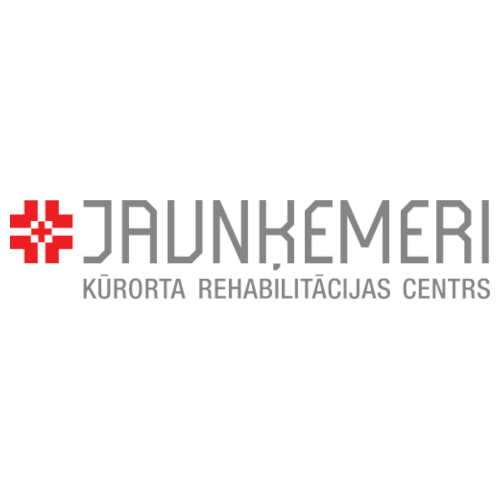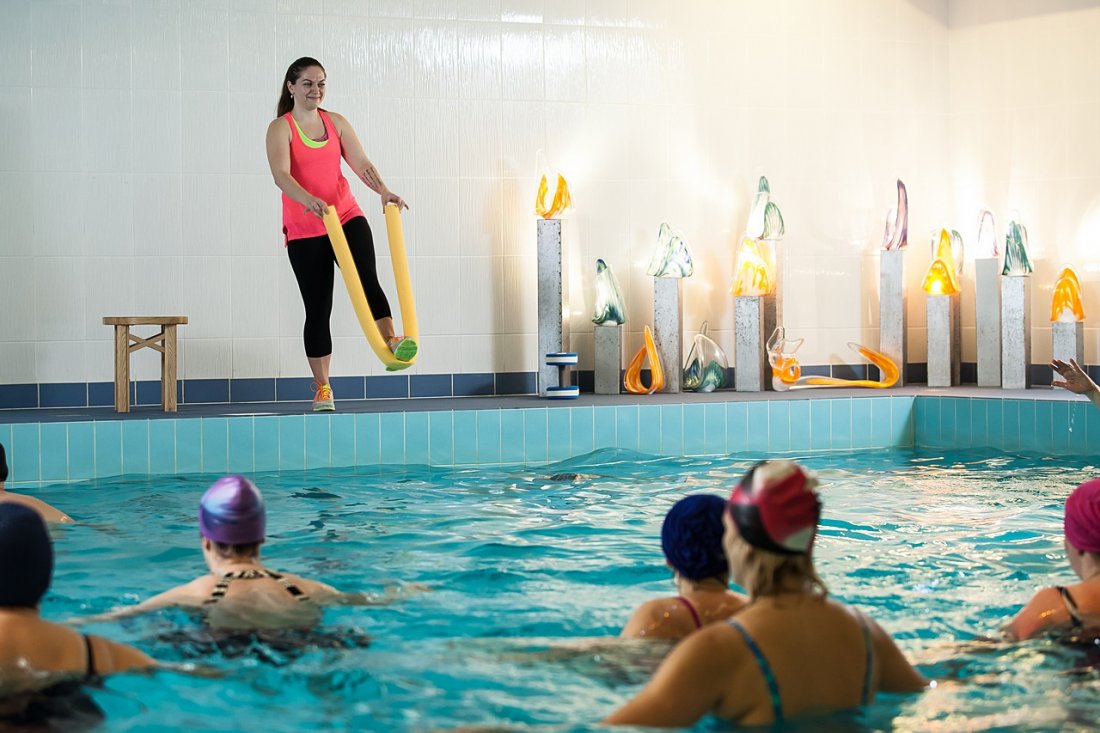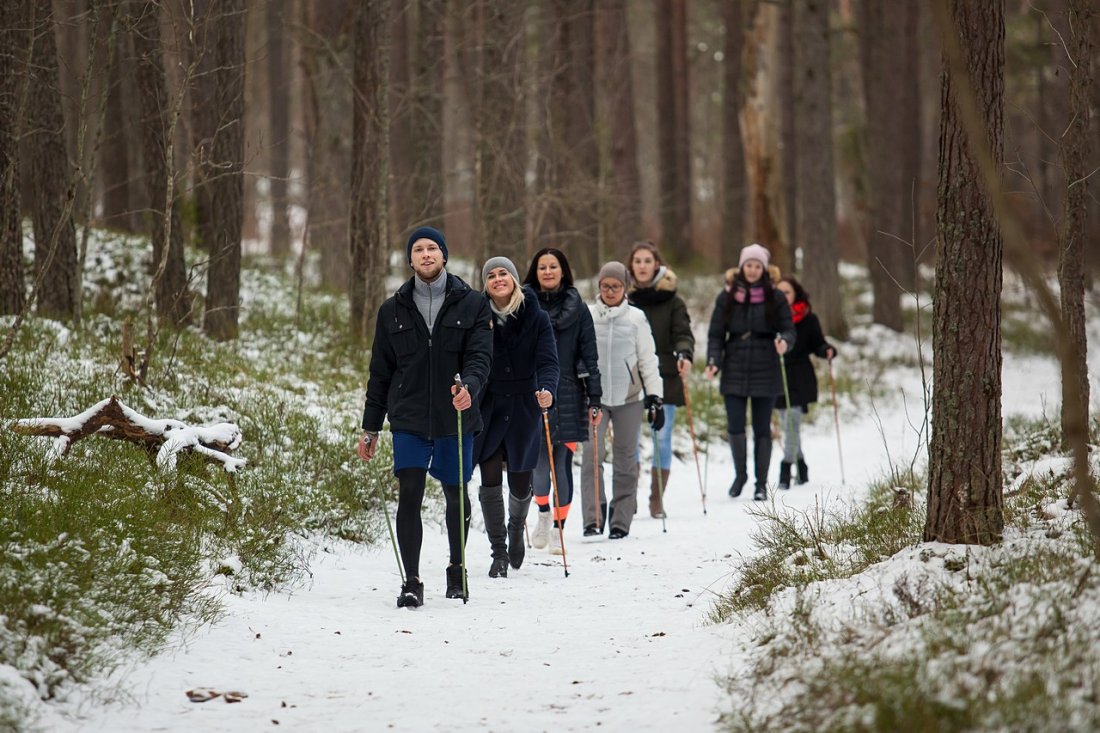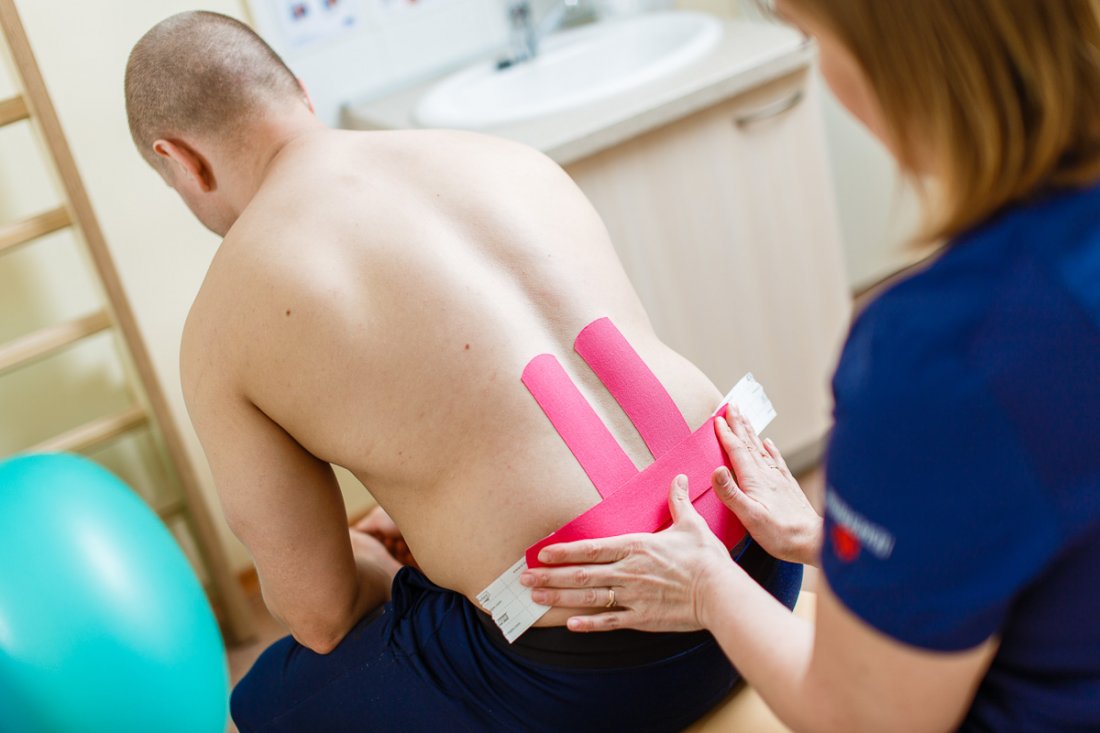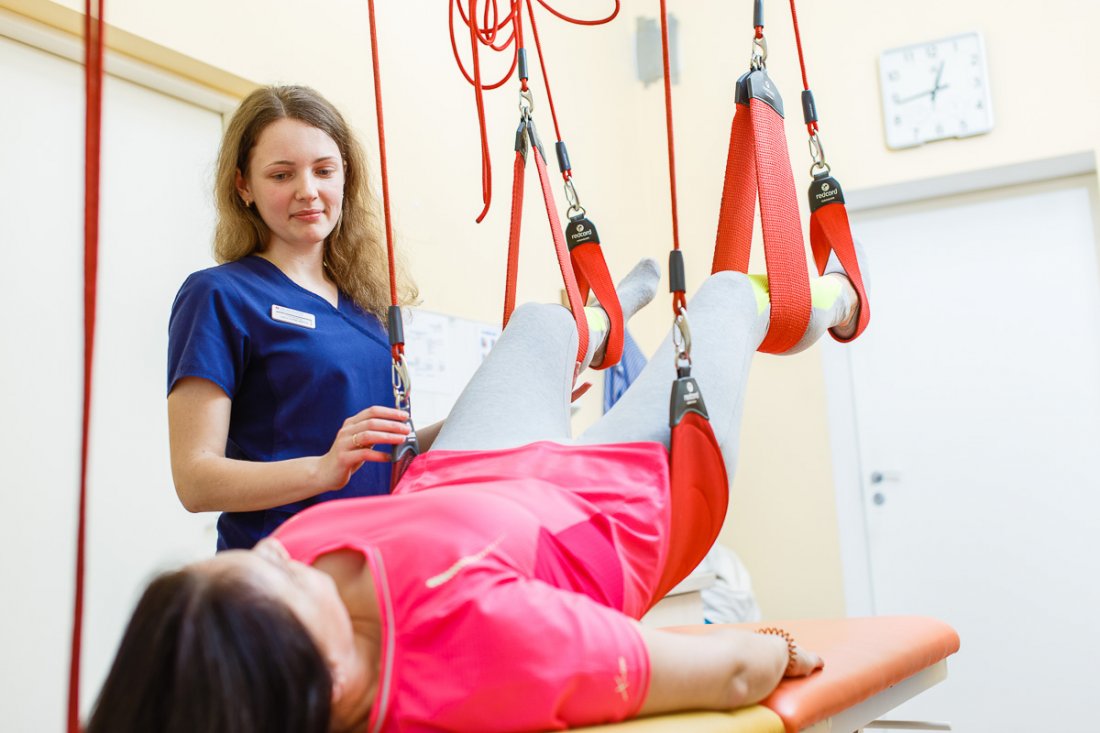Physiotherapy

Prophylaxis:
- Prophylaxis of health problems caused by sedentary lifestyle, overworking or stress
- Education of patients in risk groups for the prevention of complications
- Health promotion for children, pregnant women and elderly people
Treatment:
- Orthopaedic disorders: spinal and joint deformations, pain in pre- and post-operative period.
- Traumatology: after fractures, dislocations, ligament ruptures, sprains, burns, after surgery, etc.
- Neurology: for patients after stroke, brain or spinal injuries, patients with chronic neurological diseases (multiple sclerosis, Parkinson’s, polyneuropathy, radiculopathy, chronic headaches, balance disorders, etc.
- Internal diseases: cardiovascular disorders, respiratory diseases, gynaecological diseases, metabolic and endocrine disorders, etc.
WHAT IS A PHYSIOTHERAPY SESSION IN THE GYM?
Physiotherapy is an integral part of treatment and rehabilitation. Physiotherapy helps overcome after-effects of a disease and regain full quality of life. Physiotherapy uses both active and passive methods and patient’s involvement plays a big role. The following group physiotherapy sessions in the gym are available to our patients:
- Cervical spine physiotherapy session
- Lumbar and sacral spine physiotherapy session
- Physiotherapy for geriatric and cardiac patients session
- Healthy Back physiotherapy session
- Morning exercise session
- Balance training
- Cardio exercises in the fitness gym
HOW PHYSIOTHERAPY IN THE GYM WORKS
Physiotherapy improves joint mobility and active stability, trains torso muscles, increases muscular strength, reduces pain and muscle tension and improves coordination and balance.
WHAT HAPPENS IN A PHYSIOTHERAPY SESSION IN THE GYM
Sessions are led by a physiotherapist. Sessions take place in a physiotherapy gym. Additional equipment, such as exercise balls, poles, hand weights, resistance bands, etc., may be used during sessions. Session duration is 30-40 minutes.
Sessions consist of three parts:
1. Warm up
2. Main part
3. Cool down
WHAT YOU NEED FOR THE SESSION
Comfortable clothes, socks. Sports footwear is required for the cardio gym. For outdoor sessions, you will need outdoor clothes and comfortable footwear suitable for the weather.
WHAT IS AN AQUATIC PHYSIOTHERAPY SESSION
An aquatic physiotherapy session in the pool is an exercise routine with varying intensity that includes general and special dynamic and static exercises in the water, which strengthen main muscle groups, stabilise joints, reduce muscular imbalance and relieve back and joint pain.
HOW AQUATIC PHYSIOTHERAPY WORKS
Aquatic physiotherapy sessions in the pool have a health promoting and therapeutic effect and are based on patients’ rehabilitation goals and personal rehabilitation plans. Water is good for cardiovascular, respiratory and musculoskeletal systems. In the pool, your body moves more freely with less impact on the joints and spine while muscles work even harder as water creates additional resistance. Water helps reduce emotional load, which is good for your nervous system.
WHAT HAPPENS IN AN AQUATIC PHYSIOTHERAPY SESSION
Sessions are led by a physiotherapist. Aquatic physiotherapy takes place in groups based on a group type: therapeutic exercise with varying intensity or free swimming. Physiotherapy equipment, such as poles, hand weights, Smovey rings, etc., may be used during the sessions.
WHAT YOU SHOULD KNOW ABOUT AQUATIC PHYSIOTHERAPY SESSIONS
You should come to the session on time for hygiene procedures. You should not be late for the start of the session, because every session begins with a warm up. If you feel any discomfort during your session, inform your physiotherapist immediately.
WHAT YOU NEED FOR THE SESSION
Swimwear, swim cap, pool slippers, personal hygiene products (soap, sponge), towel.
WHO IS A PHYSIOTHERAPIST?
A physiotherapist is a health practitioner, i.e. a functional specialist who assesses person’s functional status and analyses how it affects person’s daily activities (including work) and well-being (e.g. pain). After careful examination and assessment of the patient, working together with the patient and where necessary involving relatives, e.g. children, therapy goals are set and methods of treatment appropriate and acceptable for the patient are chosen.
METHODS USED BY PHYSIOTHERAPISTS
During treatment, physiotherapists use both active and passive therapy methods. Patient’s involvement in the treatment process is an important prerequisite for successful physiotherapy. You cannot simply go to a pharmacy, buy ‘medicines’ prescribed by a physiotherapist, take them and put them in your cabinet. A physiotherapist’s prescription is likely to contain active exercises that you will have to do yourself, relaxation time after a stressful day at work using special relaxation techniques or fresh air walks at certain cadence and heart rate. Some of the main physiotherapy methods are therapeutic exercise (both active and passive with various goals, such as improvement of muscular or respiratory function, improvement of body sensation, etc.) with or without special equipment, balance and coordination exercise, relaxation techniques, soft tissue techniques and joint mobilisation, special therapies: Bobath therapy, PNF, Feldenkrais method and other physical factors (heat and cold therapy, ultrasound, TENS, etc.), teaching how to use exercise equipment and aids, etc.
WHEN IT IS RECOMMENDED
Physiotherapy is also used to promote and strengthen heath and as a disease prevention method. Correctly selected and dosed physical activities are important physiotherapy methods for the prevention (prophylaxis) of cardiovascular diseases and diabetes and reduction of obesity risk. Correctly executed active exercises can help reduce muscle and ligament tension caused by everyday rush and maintain sufficient muscle strength and length, which will allow to avoid discomfort, pain and problems with joints at a later stage. Timely detection and correction of postural problems in schoolchildren will allow preventing serious development problems as they grow. The list can go on, as adequate physical activities and relaxation exercise are a part of the fundamental health promotion measures.
WHAT HAPPENS IN PERSONAL PHYSIOTHERAPY SESSIONS
At the beginning, patient’s physical functional status and possible health risks in their daily life (e.g. non-ergonomic working posture), recommendations for health promotion and disease prevention are drawn up specifically for that patient because we are all different and have our own abilities, limitations, desires and life goals.
WHAT YOU NEED FOR THE SESSION
Comfortable clothes and socks.
WHAT IS NORDIC WALKING?
Nordic walking is a highly effective health promotion activity which involves a walking technique with special poles creating uniform load on the body.
HOW NORDIC WALKING WORKS
Nordic walking involves about 90% of muscles in a human body and it is more effective than walking without poles, since special technique of walking with poles increases exercise efficiency by almost a half. Almost all muscle groups work during Nordic walking.
Rhythmical and coordinated movement of legs and arms helps improve posture and promotes coordinated work of the respiratory system. Nordic walking improves body posture and ensures healthy, quality sleep and general wellness.
WHEN NORDIC WALKING IS RECOMMENDED
Nordic walking improves cardiovascular system and is effective in case of wrist and shoulder pain. It helps recover after surgery or injuries. Nordic walking is recommended for patients with excessive weight or metabolism problems and can reduce depression and tension.
WHAT HAPPENS IN A NORDIC WALKING SESSION
Sessions are led by a Nordic walking instructor and usually last 45-60 minutes. Sessions take place outdoors. The walking route is selected by the instructor depending on the general health of participants and weather conditions.
Sessions consist of three parts:
Warm up
– Warm up exercises for small and medium muscle groups, breathing and stretching exercises, learning to muse Nordic walking poles
Main part or Nordic walking
– A special walking technique with coordinated leg and arm movement and breathing rhythm (standard route is about 1-2 km on the beach)
Cool down
– Stretching, relaxation and breathing exercises
WHAT YOU SHOULD KNOW ABOUT NORDIC WALKING
Before the session, each participant received poles appropriate for their height. Where necessary, poles with adjustable length are used. The correct pole length is determined by the formula: patient’s height (cm) x 0.68.
WHAT YOU NEED FOR THE SESSION
You will need comfortable clothes suitable for the weather and comfortable sports shoes. Poles suitable for your height will be given to you before the session. If weather conditions are unsuitable (heavy precipitation, air temperature above 30 ºC or below -15 ºC), sessions are cancelled.
WHAT IS TERRAIN THERAPY
Terrain therapy is a physical load session where patient is doing a certain amount of physical exercises with varying intensity.
HOW TERRAIN THERAPY WORKS
Under physical load, person’s heart rate increases, breathing becomes deeper and more frequent, muscle tone increases and metabolism is boosted. Organised physical activity develops body’s physical properties, such as strength, speed, dexterity, endurance, flexibility and coordination in a comprehensive way. Results:
- Overall health is improved
- Cardiovascular, respiratory and other organ system function improves
- Metabolism is boosted and risk of obesity is reduced
- Posture and physical appearance are improved
- Immune system is strengthened
- Physical and mental capacity is increased
- You feel better
WHEN IS IT RECOMMENDED?
Terrain therapy is recommended for patients with cardiovascular diseases (e.g. after myocardial infarction, coronary bypass surgery, patients with chronic heart failure, high blood pressure, etc.), patients with asthma, after bronchitis and pneumonia. It is also good for patients with joint problems, if their movement is not significantly limited, and diabetes patients.
WHAT HAPPENS IN A TERRAIN THERAPY SESSION
Walking route, distance and pace are determined taking into account the patient’s functional limitations. Load is increased for each patient individually. Terrain therapy intensity is determined by the number of steps per minute:
- Slow pace – 70-80 steps per minute (3-3.5 km/h)
- Medium pace – 80-100 steps per minute (3.5-4 km/h)
- Fast pace – 100-120 steps per minute (4.5-5 km/h)
Patients must monitor changes in their heart rate during their walk.
According to physiotherapist’s instructions, patients are divided into four functional categories. Based on these instructions, the choice of routes and walking pace are explained to the patients.
WHAT YOU SHOULD KNOW ABOUT TERRAIN THERAPY
Desirable heart rate during terrain therapy walks is calculated by the following formula: 220 – age x 50%.
WHAT YOU NEED FOR THE SESSION
Comfortable clothes suitable for the weather and comfortable sports shoes.
WHAT ARE SMOVEY RINGS?
A Smovey ring is a vibrating ring system consisting of a spiral tube, 4 steel balls and a handle with shock absorbing elements. When the ring is moved forward and then in the opposite direction, four balls begin to move freely inside the tube.
HOW SMOVEY RINGS WORK
Movement of the balls move inside the spiral grooved tubes:
- Activates and strengthens superficial and deep muscles
- Boosts metabolism and burning of fat
- Improves functioning of the lymphatic system
- Strengthens connective tissue
- Improves movement coordination and balance, helps endurance training
- Reduces tension in the neck, shoulder and back areas
- Stimulates reflex zones and cell activity
- Strengthens immune system
- Produces vibrating effect
WHO CAN BENEFIT
Smovey rings are suitable for everyone—young and old, sick and healthy, physically active or sedentary—so everyone exercising with Smovey rings will be a winner. Smovey rings are great for indoor training both at home and in a gym throughout the year. Outdoor and aquatic sessions are also very enjoyable. Green colour of the rings matches nature perfectly. Green is the colour of harmony and balance and has beneficial effect on human body. Exercising with Smovey rings is an alternative to Nordic walking (in poor weather and in winter you can exercise at home). You do not need much space for that. If you exercise daily, you will only need 10-15 minutes for it to be effective. If you cannot exercise daily, recommended work out duration will be 40-50 minutes 2-3 times a week. The most important in exercising with Smovey rings are correct grip, movement, arm motion range and vibration created by the balls. You can learn how to exercise correctly in sessions with our specialists.
WHAT YOU NEED FOR THE SESSION
Comfortable clothes suitable for the weather and comfortable sports shoes. Smovey rings will be given to you before the session.
WHAT IS KINESIOLOGY TAPING?
Kinesiology taping originates from Japan and Korea. The taping method is rooted in the idea that muscle movement and activity are essential for preserving or restoring health and is based on knowledge of muscle structure and function.
WHAT RESULTS CAN BE ACHIEVED WITH KINESIOLOGY TAPING?
Kinesiology taping is designed to promote body’s self-healing processes. Targeting affected muscles, it activates body’s self-restoration process.
Kinesiology tape works deeper than skin focusing on subcutaneous structures, muscles, ligaments and tendons, which in turn affects circulation, lymphatic vessels, capillaries and receptors.
Use of different kinesiology taping techniques can have the following benefits:
- Improving muscle function by regulating muscular tone
- Correcting joint deformation by stabilising joints, ligaments and tendons in their anatomically correct positions
- Alleviating pain by reducing pressure on a specific body part and improving circulation
- Neutralising vascular and lymphatic congestion reducing oedema
- Accelerating scar tissue maturation using special taping technique for scar tissue mobilisation
The kinesiology taping concept is very versatile and is suitable for adults, children and babies alike.
WHEN IS IT RECOMMENDED?
- Acute and chronic pain (headaches, back pain, nerve damage, etc.)
- Joint, ligament, muscle or tendon injuries
- Congenital or acquired deformities
- Post-surgery scar tissue
- Circulation or lymphatic system disorders (swelling, oedema)
HOW KINESIOLOGY TAPING IS DONE
Our physiotherapist examines the patient, assesses passive and active mobility and runs tests in accordance with kinesiology principles. After that, the specialist chooses the method and type of application for that particular patient, prepares materials and applies the tape to the problem areas.
WHAT YOU SHOULD KNOW ABOUT KINESIOLOGY TAPING
Kinesiology taping is applied by a professional (physiotherapist, occupational therapist or other specialist) who has had training and is duly certified. Kinesiology tape is made of 100% cotton fibres which allow skin to breathe thus reducing the risk of irritation. The tape is light and permeable, but at the same time water-resistant, so you can take a shower or bath or go to a swimming pool. Its properties allow wearing tape from a couple of days to several weeks without losing its unique effect. Contact with water may reduce wear time and the tape may come off sooner.
WHAT IS SLING THERAPY?
Sling or elastic cord therapy is a method of physiotherapy using special equipment for patient rehabilitation.
HOW SLING THERAPY WORKS
During therapy sessions, muscles relax, pain is alleviated and minor lumbar and/or cervical traction (pulling or stretching method) is possible. Sling therapy improves active mobility and stability of joints.
WHO CAN HAVE SLING THERAPY
Sling therapy is suitable for:
- Anyone who wants to stay in shape
- People with musculoskeletal problems, headaches or back pain
- People with sedentary work or lifestyle (office workers, long-distance drivers, hairdressers, etc.)
- New mums and women whose posture changed after pregnancy, who experienced back pain during pregnancy or developed back pain after giving birth
WHAT HAPPENS IN A SLING THERAPY SESSION
During the sessions, cervical and/or lumbar muscles relax, deep muscles strengthen and movement is improved. Session duration is 30 minutes. The patient lies on the treatment table on the back or on the side in a relaxed position. Depending on what part of the spine is targeted and stretched (cervical and/or lumbar), the patient is suspended in the sling. Before stretching, the physiotherapist relaxes, frees and warms up the muscles using manual techniques on soft tissues.
WHAT YOU NEED FOR THE SESSION
Comfortable clothes and socks.


